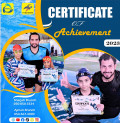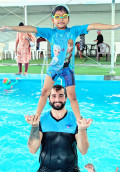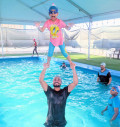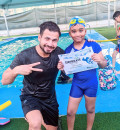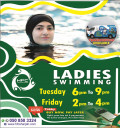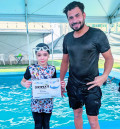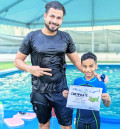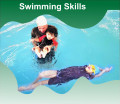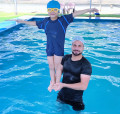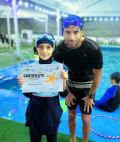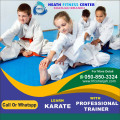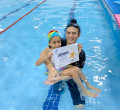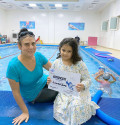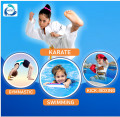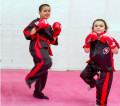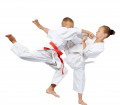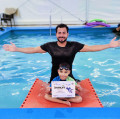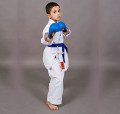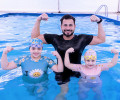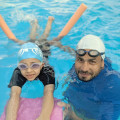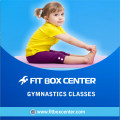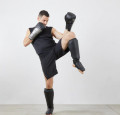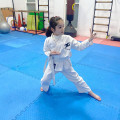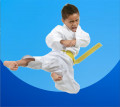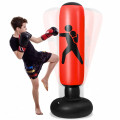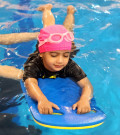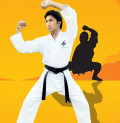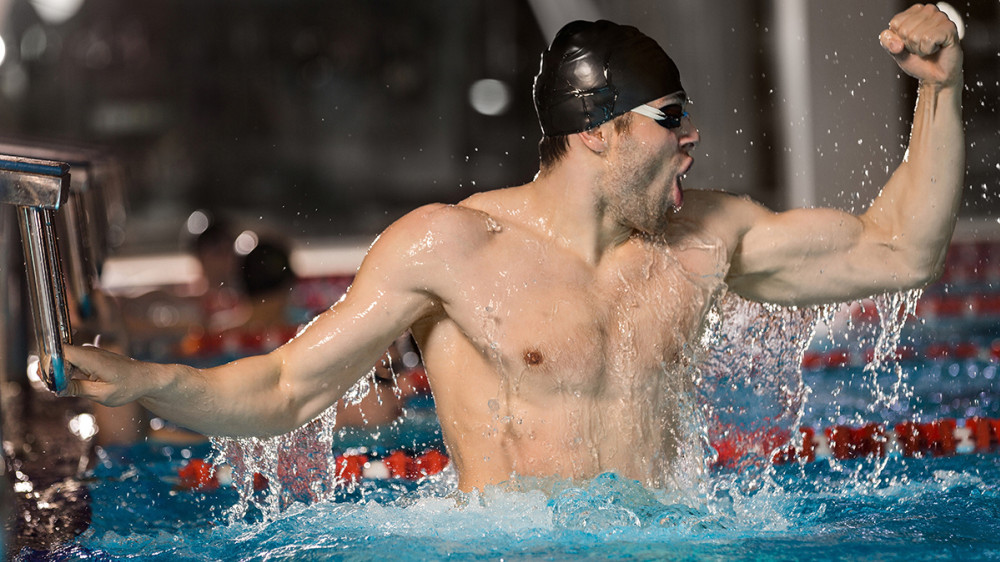
Swim Workouts for Having a Lean, Muscular “Swimmer’s Body”
2023-01-14 - Swimming
Swimming is an exercise that brings about changes in our body. With regular swimming swimmers attain broad-shouldered, thin, slightly elongated and fit body shape.
Swimming is an exercise method that is gentle on your body, and highly beneficial and a combination of the following bring about the physical changes in the body.
· Breaststroke, front crawl, butterfly, and back crawl sculpts shoulders and arms.
· Swimming will help to get the desired abs, and rather quickly.
· Swimming, especially doing the backstroke, will work wonders for back muscles.
· Regular swimming also works your glutes like no other exercise.
· Every type of swimming involves movements with legs, which means they will get sculpted with the regular swim exercise.
Swimmers are often known for having a lean, muscular “swimmer’s body” which is the result of hard work they put into their training, nutrition and recovery. Swimming is a great form of cardio exercise and can be a challenging workout for both the upper and lower body.
Popular swim workouts:
Distance swims:
Distance swims involve swimming a set distance, such as 500 meters or 1000 meters, at a steady pace. This type of workout is great for building endurance, stamina, and overall fitness. Here are a few tips for completing a distance swim:
Warm up: It's important to start with a warm-up to prepare your body for the workout. This can include a few easy laps of freestyle or breaststroke, and some stretching exercises.
Set a pace: It's important to set a steady pace that you can maintain throughout the entire distance swim. This will help you to conserve energy and prevent fatigue.
Use proper technique: Focus on using good technique throughout the swim to conserve energy and prevent injury.
Monitor your breathing: It's important to breathe regularly and evenly to keep your body oxygenated and prevent fatigue.
Take breaks: If needed, take short breaks during the swim to catch your breath, check your form, and regroup before continuing.
Cool down: Finish your workout with a cool-down, which can include a few easy laps of freestyle or breaststroke and stretching exercises.
Interval training:
Interval training swim workout involves alternating periods of intense swimming with rest or recovery periods. This type of workout is great for building endurance, improving technique, and increasing overall fitness.
An example of a basic interval training workout:
Warm-up: Swim easy for 5-10 minutes to get your body ready for the workout.
Interval Set:
Swim hard for 30 seconds (at or near maximum effort)
Rest for 30 seconds
Repeat this set 8-10 times
Main Set:
Swim at moderate intensity for 4-6 minutes
Rest for 2 minutes
Repeat this set 4-6 times
Cool-down: Swim easy for 5-10 minutes to cool down and recover.
This is a basic example and can be modified to match your fitness level, and preferences. For example, you can increase or decrease the duration of the intense and rest intervals, or the number of sets. Interval training is a great way to boost cardiovascular fitness and endurance
Drills:
Drills are specific exercises or techniques that are used to improve a swimmer's overall performance. They are often used to focus on a specific aspect of swimming such as body position, stroke technique, or breathing. Common examples of swim drills include freestyle drills like the catch-up drill and the fist drill, and breaststroke drills like the single arm drill and the dolphin kick drill. Drills can be incorporated into a swim workout to provide variety and target specific areas for improvement.
Endurance sets:
Endurance sets in swimming refer to training sessions where the goal is to build endurance and stamina by performing a high number of laps or meters with consistent effort and pace. These sets are typically longer in duration and lower in intensity than speed or power sets. Some examples of endurance set in swimming include:
Continuous swim: A set where the swimmer swims a certain distance (e.g., 1000 meters) without stopping.
Ladder swim: A set where the swimmer starts with a shorter distance (e.g. 100 meters) and gradually increases the distance with each repeat (e.g. 200 meters, 300 meters, etc.).
Descend set: A set where the swimmer starts with a longer distance (e.g. 400 meters) and gradually decreases the distance with each repeat (e.g. 300 meters, 200 meters, etc.).
Interval swim: A set where the swimmer swims a certain distance (e.g. 100 meters) at a steady pace, followed by a short rest, and repeats for a specified number of times.
Pull sets:
Pull sets in swimming refer to training sessions that focus on the pulling motion of the stroke, such as the freestyle or breaststroke. These sets typically involve using a pulling aid such as a pull buoy or paddles to isolate the upper body and arm muscles or using a kickboard to isolate the core and leg muscles.
Some examples of pull sets in swimming include:
Pull buoy set: A set where the swimmer uses a pull buoy to float the legs and isolate the upper body muscles, performing a high number of laps or meters of the stroke of choice.
Paddle set: A set where the swimmer uses paddles on their hands to increase resistance and build upper body strength, performing a high number of laps or meters of the stroke of choice.
Kick set: A set where the swimmer uses a kickboard to float the upper body and isolate the leg muscles, performing a high number of laps or meters of kick.
Pull sets can be used in conjunction with other types of training, such as endurance or speed sets, to provide a well-rounded swim workout. They are typically performed with a focus on maintaining good technique and form while pushing the limits of one's strength and endurance capabilities.
Levels of Swimming:
Based on your swimming level, choose the appropriate workouts. Several levels of swimming commonly used to categorize swimmers based on their skill and experience include:
Beginner level: These workouts are designed for those who are new to swimming or are not yet comfortable in the water. They focus on building basic swimming skills and increasing overall endurance. Examples include floating, kicking, and arm strokes drills. Here are a few examples of beginner level swim workouts:
Basic Swim Workout: This workout consists of a warm-up, followed by a series of freestyle or breaststroke laps, with rest intervals in between. The goal is to gradually increase the distance and duration of each lap as you build endurance.
Kick Workout: This workout is all about building leg strength and technique. You will use a kickboard to focus on your kick and build endurance.
Floating and Glide Workout: This workout is focused on teaching you how to float and glide in the water. This will help you to learn how to conserve energy while swimming.
Drills Workout: This workout is focused on specific techniques, such as freestyle arm strokes or kick work. Drills are a great way to improve your form and technique and build strength and endurance.
Endurance Sets: This workout is focused on continuous swimming for a set distance or time. This is great for building endurance and overall fitness.
Intermediate level: These workouts are designed for those who have a basic understanding of swimming and are comfortable in the water. They focus on building endurance, improving technique, and increasing overall fitness. Examples include interval training, drills and endurance sets.
Interval Training: This workout involves alternating periods of intense swimming with rest or recovery periods. This type of workout is great for building endurance and improving speed.
Drill and Swim Workout: This workout combines a series of drills with lap swimming. The drills focus on specific techniques, such as freestyle arm strokes or kick work, while the lap swimming allows you to practice the techniques you've learned during the drills.
Pull Sets: This workout is focused on upper body strength and technique. Using a pull buoy and a paddle will help to improve your form and build strength in your shoulders, back, and arms.
Endurance Sets: This workout is focused on continuous swimming for a set distance or time. This is great for building endurance and overall fitness.
Pyramids: This workout involves swimming a set distance, such as 50 meters, and then gradually increasing the distance with each successive swim. For example, you may swim 50 meters, then 100 meters, then 150 meters, and so on.
Advanced level: These workouts are designed for experienced swimmers who are looking to push themselves to the next level. They focus on building strength, power, and speed. Examples include: pull sets, and high-intensity interval training.
Here are a few examples of advanced level swim workouts:
High-Intensity Interval Training (HIIT): This workout involves intense, short bursts of swimming, followed by short recovery periods. This type of workout is great for building power and endurance.
Speed Sets: This workout is focused on building speed and power. It involves swimming short, fast laps at maximum effort, with rest intervals in between.
Endurance sets with increasing pace: This workout is focused on building endurance while working on speed. You swim a set distance and then you increase the pace of your swim each time you finish the set distance.
Pull Sets with added resistance: This workout is focused on upper body strength and technique. By using a pull buoy and a paddles, you can add resistance to your workout to increase the intensity and focus on specific muscle groups.
Race-Specific Training: This workout is focused on preparing for a specific event, such as a triathlon or open water swim. This type of workout involves simulating race conditions, such as drafting and sighting, to help you be better prepared for the actual event.
It is important to consult with a coach or trainer, or to seek professional advice before starting any workout routine to ensure that it is appropriate for your level of fitness and to prevent injuries.
.







.jpg)




















